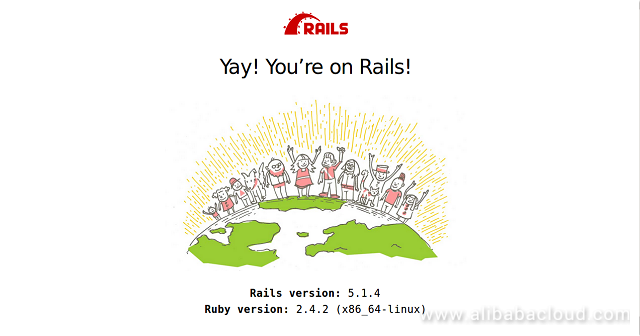By Hitesh Jethva, Alibaba Cloud Tech Share Author. Tech Share is Alibaba Cloud’s incentive program to encourage the sharing of technical knowledge and best practices within the cloud community.
Ruby on Rails is a free, open source server-side web application framework that allows web designers and developers to implement dynamic fully featured web applications. Ruby is easy to learn, easy to extend, and object-oriented. This means that it involves less coding and fewer bugs. That is why Ruby is gaining popularity all over the world.
You can develop a web application at least ten times faster with Rails than you could with a typical Java framework. Ruby is based on the Model View Controller architecture that enables the data to be separated from presentation. You can develop customized and search engine friendly URLs using Ruby on Rails. Ruby on Rails comes with built-in tools that make common development tasks easier. You can deploy Ruby on Rails based application with a database server like, MySQL or PostgreSQL and an Apache web server with Phusion Passenger module.
In this tutorial, we will explain how to deploy Ruby on Rails with Passenger and the Nginx web server on an Alibaba Cloud Elastic Compute Service (ECS) Ubuntu 16.04 server.
First, Login to your https://ecs.console.aliyun.com/?spm=a3c0i.o25424en.a3.13.388d499ep38szx">Alibaba Cloud ECS Console. Create a new ECS instance , choosing Ubuntu 16.04 as the operating system with at least 2GB RAM. Connect to your ECS instance and log in as the root user.
Once you are logged into your Ubuntu 16.04 instance, run the following command to update your base system with the latest available packages.
apt-get update -y
Before starting, you will need to install some packages required for building Ruby modules and running Rails applications. You can install all of them by running the following command:
apt-get install build-essential dirmngr gnupg ruby ruby-dev zlib1g-dev libruby libssl-dev libpcre3-dev libcurl4-openssl-dev rake ruby-rack -y
Once all the required dependencies are installed, you can proceed to the next step.
First, you will need to download and install RVM (Ruby Version Manager) to install Ruby. You can download and install RVM by running the following command:
`gpg --keyserver hkp://keys.gnupg.net --recv-keys 409B6B1796C275462A1703113804BB82D39DC0E3
curl -sSL https://get.rvm.io | bash -s stable`
Once RVM is installed, you will need to add all users that will be using RVM to rvm group, then log out and log in again. You can do this with the following command:
usermod -a -G rvm root
exitNext, check and install the required packages to install Ruby by running the following command:
rvm requirements
Once all the required packages are installed, you can install Ruby (version 2.4.2) with the following command:
rvm install 2.4.2
Once RVM installed successfully, you should see the following output:
ruby-2.4.2 - #extracting rubygems-2.6.14....
ruby-2.4.2 - #removing old rubygems.........
ruby-2.4.2 - #installing rubygems-2.6.14...........................
ruby-2.4.2 - #gemset created /usr/local/rvm/gems/ruby-2.4.2@global
ruby-2.4.2 - #importing gemset /usr/local/rvm/gemsets/global.gems...............................................
ruby-2.4.2 - #generating global wrappers........
ruby-2.4.2 - #gemset created /usr/local/rvm/gems/ruby-2.4.2
ruby-2.4.2 - #importing gemsetfile /usr/local/rvm/gemsets/default.gems evaluated to empty gem list
ruby-2.4.2 - #generating default wrappers........
ruby-2.4.2 - #adjusting #shebangs for (gem irb erb ri rdoc testrb rake).
Install of ruby-2.4.2 - #complete
Ruby was built without documentation, to build it run: rvm docs generate-riNext, set the default RVM version using the following command:
rvm use 2.4.2 --default
Next, install Rails (version 5.1.4) by running the following command:
gem install rails -v 5.1.4
Once Rails is installed, you can proceed to the next step.
By default, the Phusion Passenger is not available in Ubuntu 16.04 default repository. So you will need to add the repository for that.
First, install a PGP key and HTTPS support for the package manager by running the following command:
apt-key adv --keyserver hkp://keyserver.ubuntu.com:80 --recv-keys 561F9B9CAC40B2F7
apt-get install -y apt-transport-https ca-certificatesNext, add the repository to the APT with the following command:
echo "deb https://oss-binaries.phusionpassenger.com/apt/passenger xenial main" >> /etc/apt/sources.list
Next, update the APT cache with the following command:
apt-get update -y
Next, install Nginx and Passenger by running the following command:
apt-get install nginx-extras passenger
Nginx and Passenger are now installed, but support for Phusion Passenger is not enabled. You can do this by editing /etc/nginx/nginx.conf file:
nano /etc/nginx/nginx.conf
Find and uncomment the following lines:
include /etc/nginx/passenger.conf;
Save and close the file when you are finished.
Here, you are using RVM, so you will need to specify which version of Ruby should be used by Passenger in /etc/nginx/passenger.conf file.
You can find the version of the Ruby used by Passenger with the following command:
rvm use
passenger-config --ruby-commandYou should see the following output:
passenger-config was invoked through the following Ruby interpreter:
Command: /usr/local/rvm/gems/ruby-2.4.2/wrappers/ruby
Version: ruby 2.4.2p198 (2017-09-14 revision 59899) [x86_64-linux]
To use in Apache: PassengerRuby /usr/local/rvm/gems/ruby-2.4.2/wrappers/ruby
To use in Nginx : passenger_ruby /usr/local/rvm/gems/ruby-2.4.2/wrappers/ruby
To use with Standalone: /usr/local/rvm/gems/ruby-2.4.2/wrappers/ruby /usr/bin/passenger startNow, copy Nginx line from above output and paste in /etc/nginx/passenger.conf file:
nano /etc/nginx/passenger.conf
Make the following changes:
passenger_root /usr/lib/ruby/vendor_ruby/phusion_passenger/locations.ini;
passenger_ruby /usr/local/rvm/gems/ruby-2.4.2/wrappers/ruby;Save and close the file, then restart Nginx with the following command:
systemctl restart nginx
Nginx is now configured for Passenger support, it's time to deploy Rails app. Before starting, you will need to install rails gem to create a new Rails app.
You can install rails gem by running the following command:
gem install --no-rdoc --no-ri rails
Next, create a new app with the name railapp by running the following command:
cd /var/www/html
rails new railapp --skip-bundleNext, change the directory:
cd railapp
Next, you will need to install a JavaScript execution environment. First, open
the Gemfile:
nano Gemfile
Uncomment the following line:
gem 'therubyracer', platforms: :ruby
Save the file, then run Bundler with the following command:
bundle install
Next, you will need to disable Nginx default virtual host file and create a new virtual host file for railapp.
You can do this with the following command:
rm -rf /etc/nginx/sites-available/default
nano /etc/nginx/sites-available/railappAdd the following lines (replace the variable Your_Server_IP with the actual IP address of your ECS instance):
server {
listen 80 default_server;
server_name Your_Server_IP;
passenger_enabled on;
passenger_app_env development;
root /var/www/html/railapp/public;
}Save and close the file, then enable virtual host with the following command:
ln -s /etc/nginx/sites-available/railapp /etc/nginx/sites-enabled/
Finally, restart Nginx service to apply changes:
systemctl restart nginx
Your Rail app is now up and running, open your web browser and navigate to URL http://Your_Server_IP, you will be redirected to the Rail app dashboard as shown below (replace the variable Your_Server_IP with the actual IP address of your ECS instance):

Alibaba Cloud Snapshot : You can create instance snapshots to save the system state from a certain point in time for data backup or to create images.
Alibaba Cloud Web Application Firewall (WAF) can be used to provide protection against web-based attacks, including SQL injections, Cross-site scripting (XSS), Malicious BOT, command execution vulnerabilities, and other common web attacks. WAF filters out a large number of malicious access attempts and alleviates the performance impact of Hypertext Transfer Protocol (HTTP)/HTTP Secure (HTTPS) flood attacks on servers.
Video Analytics Startup SwiMMinD Joins Alibaba Cloud Startup Program
How to Configure Nginx High Availability Cluster Using Pacemaker on Ubuntu 16.04

2,599 posts | 764 followers
FollowAlibaba Clouder - November 28, 2017
Alibaba Clouder - September 6, 2019
Alibaba Clouder - December 20, 2019
Alibaba Clouder - July 19, 2018
Alibaba Clouder - November 27, 2018
Alibaba Clouder - January 27, 2020

2,599 posts | 764 followers
Follow ECS(Elastic Compute Service)
ECS(Elastic Compute Service)
Elastic and secure virtual cloud servers to cater all your cloud hosting needs.
Learn MoreLearn More
 Simple Application Server
Simple Application Server
Cloud-based and lightweight servers that are easy to set up and manage
Learn MoreMore Posts by Alibaba Clouder